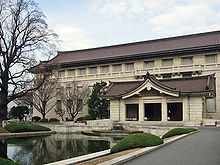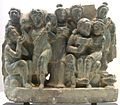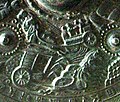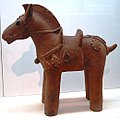Tokyo National Museum
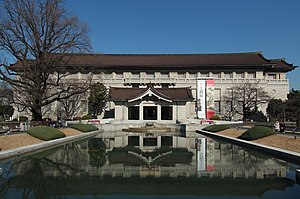 Entrance to the main building |
|
| Data | |
|---|---|
| place | Taitō-ku in Tokyo |
| Art | |
| architect | Josiah Conder |
| opening | March 10, 1872 |
| management |
Masami Zeniya
|
| Website | |
The National Museum Tōkyō ( Japanese 東京 国立 博物館 Tōkyō Kokuritsu Hakubutsukan ) was founded in 1872 and is the oldest and largest museum in Japan .
Overview
The museum collects and preserves works of art and archaeological finds from Japan and other East Asian countries. It has more than 110,000 exhibits, including 87 national treasures of Japan and 633 other important national cultural assets (as of March 2014). In addition, research projects and the organization of educational events in connection with its collections are also among the activities of the institution.
The museum is located in Ueno Park in Taitō-ku in Tokyo , where the extensive facilities of the Kan'eiji Temple, which was destroyed in the Boshin War , stood until 1868 . The museum consists of a Japanese main gallery ( 本館 , Honkan ), Asian gallery ( 東洋 館 , Tōyōkan), Hyōkeikan ( 表 慶 館 ), Heiseikan ( 平 成 館 ), the gallery of the Hōryū-ji treasures ( 法 隆 寺 宝物 館 ), a research - and information center ( 資料 館 , Shiryōkan) and other facilities. On the premises of the museum there are restaurants and shops, open-air exhibitions and a garden.
The collections located here focus on ancient Japanese art and ancient Asian art along the Silk Road . There is also a large collection of Greco Buddhist art .
All information is available in Japanese , Korean , Chinese , English , French and German .
history
The Museum Department of the Ministry of Education held Japan's first museum exhibition in the Taiseiden Hall in 1872. Soon after, the museum moved to Uchiyamashita-chō (now Uchisaiwai-chō ), then in 1882 to its present location in Ueno Park. Major events were the Great Kantō earthquake in 1923 and the temporary closure during the war in 1945. In the more than 120 years of its history, the museum has been subject to strong development and numerous changes due to administrative reforms and changes.
The museum also changed its name several times from "Imperial Museum" in 1886 to "Tokyo Imperial Court Museum" before 1900 to its current name since 1900.
The five galleries
Japanese gallery
It offers a general overview of Japanese art in 24 exhibition rooms on two floors. It consists of exhibitions from 10,000 BC. BC to the late 19th century, exhibitions on various types of art such as ceramics, sculpture and swordsmithing as well as themed exhibitions.
The original main gallery, designed by British architect Josiah Conder , was severely damaged during the Great Kanto earthquake in 1923. In contrast to the more western style, the design of today's Honkan by Watanabe Jin is built in the more Japanese-influenced "imperial crown style". Construction began in 1932 and the inauguration took place in 1938. In 2001 it was classified as a Significant Cultural Property of Japan .
Bodhisattva , Asuka period , 7th century
Nakahama Manjirō's report of his travels, map from around 1850
Asian gallery
It consists of ten exhibition rooms on five levels and is dedicated to the art and archeology of Asia including Korea , China , India and Southeast Asia , as well as exhibits from Egypt .
The museum houses one of the world's largest and most important collections of Korean art , especially Celadon ceramics. More than 1000 gold, bronze and celadon pieces from the estate of the businessman Takenosuke Ogura now form the core of the Korean collection. A total of 4800 exhibits of Korean origin, including around 2000 archaeological finds, are exhibited or stored in the museum.
The building was designed by Taniguchi Yoshio and opened in 1968. There is a restaurant and a museum shop on the ground floor.
Bacchanal scene, representation of the grape harvest , Greco-Buddhist art from Gandhara, 1st – 2nd centuries. Century
Buddha Maitreya , Northern Wei , 443
Hyōkeikan
Originally built by the architect Katayama Tōkuma to commemorate the marriage of the Meiji Crown Prince and later Emperor Taishō , the Hyōkeikan was opened in 1909. This building is considered a major cultural asset of Japan as an example of western-style architecture of the late Meiji period . It is only accessible for events and special exhibitions.
Heiseikan
The Heiseikan mainly serves as a space for special exhibitions, but also houses the exhibition on Japanese archeology. This exhibition on the third floor of the building shows Japanese history from ancient times to premodern times using archaeological objects as an example. The rooms on the second floor are reserved for special exhibitions. The Heiseikan building was opened in 1999 to commemorate the wedding of the Crown Prince. It also includes an auditorium.
The gallery shows some examples of corded ceramics from the Jōmon period , around 10,000 BC. The real age of these pieces was not determined by the radiocarbon method until after World War II .
The earliest known polished stone tools in the world. Japanese Paleolithic 30,000 BC Chr.
Horse-drawn carriage from the Kofun period . Detail of a bronze mirror (5th – 6th centuries). Eta-Funayama Tumulus, Kumamoto .
Haniwa - horse statue with saddle, stirrups, 6th century
The Gallery of Hōryū-ji Treasures
Works of art from the 319 Hōryū-ji treasures donated to the Imperial Court by Hōryū-ji in 1878 are exhibited in six rooms. The building was designed by Taniguchi Yoshio and equipped with the latest preservation technology. It was reopened in 1999 after a complete renovation. The "reference room" on the mezzanine floor of the second floor houses the "digital archive", which allows the visitor to view all the pieces of the "Hōryū-ji treasures" on the computer with explanations in several languages.
Research and information center
It was built in 1984 mainly for scientific purposes. It deals with various documents on archaeological objects, performing and applied arts, and historical material throughout Asia and the Middle East, with a particular focus on Japanese cultural heritage .
Visitors can view books, magazines and large-format art books, as well as black and white and color photos in the photo cabinets. Entry is free and most of the material is in Japanese.
Available material:
- Books and magazines (Japanese, Chinese, European) including exhibition catalogs and archaeological reports
- Color and black and white photos of arts, crafts and archaeological finds from Japan, Korea, China and other Asian countries, mainly from the museum's collections
Reproductions of the images for scientific and commercial purposes are available as color copies , digital data, or prints.
See also
Web links
- Official website of the Tokyo National Museum
- Tokyo National Museum at Japan.Travel
- Tokyo National Museum on Google Arts & Culture
Individual evidence
- ↑ Yushima Seido Exposition. In: TNM.jp. Retrieved on August 21, 2020 (English).
Coordinates: 35 ° 43 ′ 8.4 ″ N , 139 ° 46 ′ 32.6 ″ E
